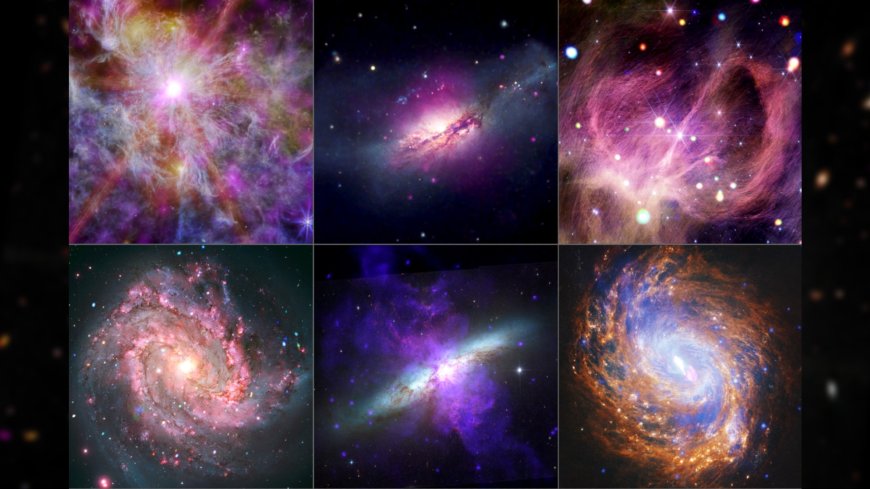NASA Reveals Stunning New Images of the Cosmos from Chandra X-ray Telescope
NASA has released a breathtaking collection of cosmic images captured by the Chandra X-ray Observatory. The images showcase stellar, nebular, and galactic activity in incredible detail, highlighting phenomena such as stellar winds, supernova remnants, and black hole activity.

NASA has unveiled a dazzling new collection of cosmic images from the Chandra X-ray Observatory, capturing spectacular stellar, nebular and galactic activity in unprecedented detail.
The collection showcases nine composite images that combine Chandra's X-ray data with observations from other space and ground-based telescopes across the infrared, optical and radio spectrum, according to a statement releasing the new images on Wednesday (July 23).
Among the highlights are spectacular views of the star-forming region N79 in the Large Magellanic Cloud, the vibrant spiral galaxies M83 and NGC 1068, and the Milky Way's own Westerlund 1 — the most massive star cluster in our galaxy and one of the closest super star clusters to our solar system. Each image illustrates Chandra's unique ability to detect high-energy phenomena, such as stellar winds, supernova remnants and black hole activity.
Clockwise from top-left: Star-forming region N79, spiral galaxy NGC 2146, star-forming region IC 348, galaxies M83 and M82, nearby spiral galaxy NGC 1068, young star cluster NGC 346, merging galaxy pair IC 1623, and \"super\" star cluster Westerlund 1 as seen by NASA's Chandra X-ray telescope in conjunction with other observatories like the Hubble Space Telescope, the James Webb Space Telescope, the Las Cumbres Observatory in Chile, the Very Large Array radio observatory, and the Kitt Peak Observatory.
The stunning new image of N79 — a nebula spanning roughly 1,630 light-years, whose vast clouds of gas and dust act as a stellar nursery — was created using X-ray data from Chandra and infrared data from the James Webb Space Telescope (JWST). The X-ray data reveals the hot gas created by young stars, which helps astronomers better understand how stars like our sun formed billions of years ago, officials said in the statement.
The spiral galaxy M83 is captured face-on, providing a clear view of its full structure. Chandra's X-ray data reveals remnants from widespread stellar explosions, or supernovas, while ground-based optical observations highlight its sweeping arms and mix of hot, young blue stars and cooler, older red ones.
Another mesmerizing spiral galaxy featured in this latest collection is NGC 1068, located relatively close to the Milky Way. It hosts a central black hole twice as massive as our own, from which a million-mile-per-hour winds stream and light up the galaxy's core in X-rays captured by Chandra.
The composite image of NGC 1068 also includes radio observations from the National Science Foundation's (NSF) Very Large Array (VLA) in New Mexico, as well as optical data from the Hubble Space Telescope and JWST. Together, the data reveals different layers of the galaxy's structure and energetic processes, highlighted by bright gold light in the image.
Chandra's latest glimpse of Westerlund 1 offers a dazzling view of the star cluster, abundant with intense star formation. Chandra's X-ray data, combined with observations from the JWST and Hubble, reveals thousands of stars emitting X-rays within this bustling stellar nursery.
Other featured targets include the colliding galaxy pair IC 1623, the starburst galaxy M82 with its X-ray-blown gas plumes, star-forming hotbeds IC 348 and NGC 346, and an edge-on spiral galaxy NGC 2146, which boasts a dusty arm that blocks the view of its center from Earth's perspective.
Now in orbit for over 25 years, Chandra remains one of NASA's most powerful space telescopes, delivering ultra-sharp images that help astronomers map cosmic structures in remarkable detail.
According to the source: Space.
What's Your Reaction?
 Like
0
Like
0
 Dislike
0
Dislike
0
 Love
0
Love
0
 Funny
0
Funny
0
 Angry
0
Angry
0
 Sad
0
Sad
0
 Wow
0
Wow
0

























































































































































































